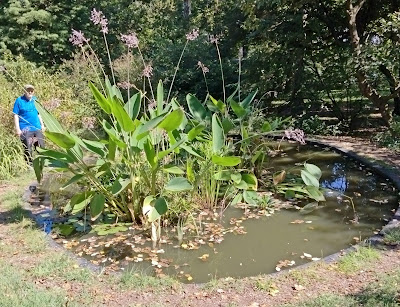Bartram's Garden was founded in 1728 by John Bartram, known as the father of American botany. Being the oldest botanical garden to survive in North America, it is now a public garden in the city of Philadelphia.
 |
| Bartram's Garden is located on the Schuylkill River, on what was farmland in the time of Bartram; now we have a view of the Philadelphia skyline |
 |
| The sign states specifically not to dump brush, yard waste or compost; however, it seemed that Bartram's Garden itself left this brush and yard waste |
 |
| Ricinus communis/Castor Bean (KSS) |
 |
| Sankofa Community Farm grows more than 60 crops and wild foods of the African Diaspora |
 |
| The Farm Education Center is an energy net-zero classroom with a teaching kitchen |
 |
| A ripe fig in the orchard that has 130 different fruit and nut trees |
 |
| The Sankofa Community Garden is for residents of Southwest Philadelphia who share the farm's focus on the African Diaspora culture and foodways |
 |
| Aesculus parviflora/Bottlebrush Buckeye fruit; the plant was first collected by William Bartram, son of John, in the 1770s |
 |
| Dolichovespula maculata/Bald-faced Hornet (which is actually a wasp) nest (KSS) |
 |
| Gate into the Ann Bartram Carr Garden, planted as a 19C exhibition garden; Ann Bartram (the daughter of John Bartram, Jr and granddaughter of John Bartram) was the third generation to manage the gardens |
 |
| Bartram House (1728-1731, kitchen addition c 1740, second story 1758-1770) is constructed with hand- quarried Wissahickon schist; Ann Bartram added the dormers and the two one-story additions |
 |
| Greenhouse and seed house (1760) was heated by a Franklin stove |
 |
| Under the window of the seed house are stone tiles carved by John Bartram with botanic designs |
 |
| Coach House (c 1850 expansion of a barn for Andrew Eastwick, who purchased the property from Ann Bartram Carr, and decided to preserve the Bartram House and build his own mansion eleswhere (now gone) |
 |
| The Welcome Center is in the former Stables |
 |
| The dovecote end of the stables from the stableyard |
 |
| The Lath House (2000 for restrooms) and barn (1775), which is the oldest barn in Philadelphia County |
 |
| Native Medicinal Plant Display was inspired by a 1751 treatise written by John Bartram |
 |
| Vigna caracalla/Snail Flower (KSS) |
 |
| Cladrastis kentukea/Yellowwood Tree is a specimen sent to Bartram by André Michaux, who found the species in 1796 in central Tennessee |
 |
| The flower of the Franklinia |
 |
| 1783 Plant Catalogue Display of the native trees and shrubs offered for sale from the Bartram nursery |
 |
| Taxodium distichum/Bald Cypress is a replacement for one planted by John Bartram, which was felled by a storm in 1920 |
 |
| Water Garden and Pond with native aquatic plants |
 |
| Green seed pods of Hibiscus lasiocarpos/ Hairy-fruited Hibiscus (KSS) |
 |
| Dried out seed pods of Hibiscus lasiocarpos/ Hairy-fruited Hibiscus (KSS) |
 |
| Hibiscus coccineus/Scarlet Rosemallow (KSS) |
 |
| Colchicum autumnale/Autumn Crocus is not a true crocus (KSS) |
 |
| Asimina triloba/Pawpaw grove |
 |
| A couple Pawpaw fruit |
 |
| View of the Schuylkill River from the boardwalk |
 |
| Bartram's Garden Dock was busy with kayakers |
 |
| Bartram's Garden Community Boathouse! |
 |
| Lonicera maackii/Amur Honeysuckle is invasive and it was dominant in the natural woods of Bartram's Gardens; also the berries are toxic to humans |
 |
| Bartram's Garden Meadow is reclaimed land of a cement factory that operated 1925-1977; the neighborhood name of Kingsessing is Lenape for "place where there is a meadow" |
 |
| We found seven beehives in the meadow |
 |
| Brynne and Kent on a "boat bow" bench |
 |
| Brynne is fostering "Cheetah Girl" who accompanied us today (KSS) |




No comments:
Post a Comment